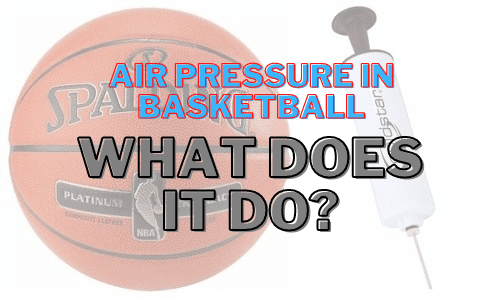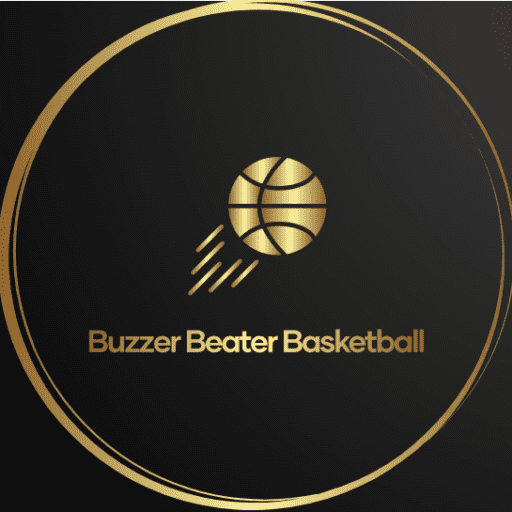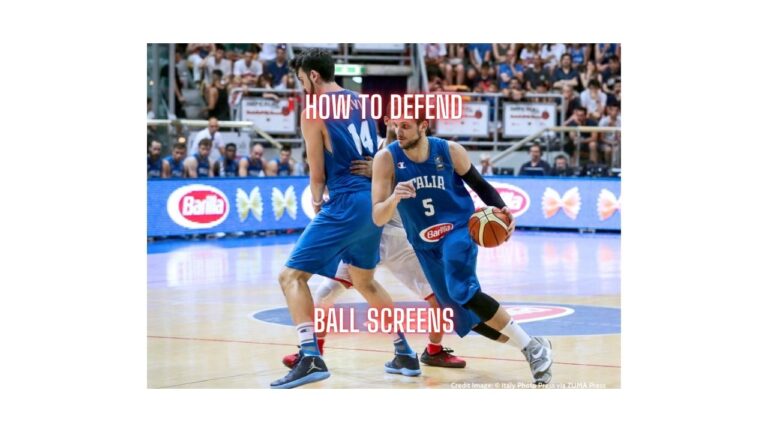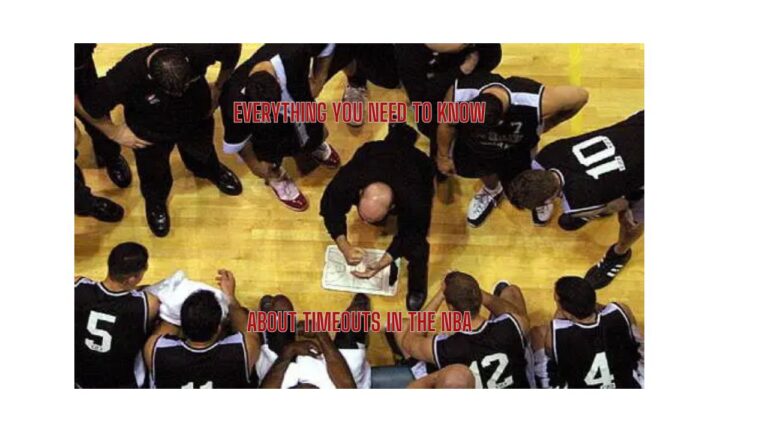Everything You Need To Know About Air Pressure and Basketballs

If you’re a regular basketball player you will have undoubtedly noticed that some balls seem to bounce faster and higher than others, many basketball players believe the differences are because of different brands selling basketballs using different manufacturing processes. Many players for example think Spalding is better than Nike, Franklin, Champion Sports, MacGregor and Fanmats but to be honest the quality of the bounce in a basketball is almost entirely based on the air pressure in the basketball. When it comes to brands most people are biased so this is normal so we decided to look into it to see what air pressure should be in a basketball and what effects different amounts of air pressure have on the basketball.
What does Air Pressure Mean?
Air pressure is described as a force that pushes air against every other object that is in contact with the air. The more air that is contained in an enclosed space, the greater the pressure that is caused. Basketballs have air pumped into them to give them their shape by expanding the bladder inside that is inside it, the air inside the ball pushes against it and stops the basketball from folding in your hands. This is because air is matter and still has weight, volume and mass so as you pump a ball up and the air fills up the inside it eventually runs out of room to expand which applies pressure to the ball and gives it some rigidity.
How Does Pressure Affect The Bounce Of A Basketball?
So in general the more air and subsequently air pressure in the basketball the higher and stronger the bounce and less air and air pressure in the basketball leads to a weaker and lower bounce. If your basketball is struggling to bounce up to the normal level it is probably under pumped and requires more air pressure, if the basketball bounces too easily and/or too high it means there is too much air pressure in the basketball. It’s much more common for a basketball to be underpumped than overpumped however it does still happen.
If your basketball has the incorrect air pressure it leads to you overcompensating when bouncing, this can lead to problems as when you practice with a ball that has incorrect air pressure it ruins muscle memory and can lead to struggles when you finally play with a basketball that does have the correct amount of air pressure. If you’re used to a ball that’s under pressured and needs power to get it to bounce then you will end up losing control of your dribble a lot as you overpower each and every bounce of the ball, remember how you train is how you play so make sure that your basketball is pumped up to the required amount of air pressure.
The Third Law of Motion states that “in every action there is always an equal and opposite reaction”. Applied to the bounce of a basketball this tells us that when you dribble the ball you provide some downward force along with gravity to make the basketball bounce, when the basketball impacts the ground the air pressure along with the downwards force of the dribble causes the ball to bounce back up.

Does The Air Pressure Affect The Shot?
Shooting jump shots in basketball is affected by a multitude of factors and yes air pressure is one of them. The trajectory and mechanics of a shot will not differ too much unless the air pressure in the ball has dropped so much that it is soft and easily compressed by touching it however air pressure has a bigger more significant impact on your shot and that is unless you get a perfect swish a ball with higher air pressure is more likely to bounce out on contact with the rim and create a long rebound, lower air pressure increases the chances of the ball dropping in on contact with the rim or creating a shorter rebound.
How Much Pressure Does A Basketball Need?
Air Pressure is measured in Pressure Per Square Inch (Psi) and most basketballs require around 8 Psi to be considered properly inflated. The NBA itself recommends a Psi between 7.5 and 8.5 and many basketball manufacturers print inflation instructions saying to recommend 7 to 9lbs Psi on their basketballs.
FIBA on the other hand use a different rule stating that a basketball should not bounce any higher than 70 inches and must not bounce any lower than 47 inches. FIBA’s rule is a lot simpler for the everyday person to do as pressure gauges aren’t usually found laying around and most basketball players don’t carry one.
A simple test that players can do to check their ball’s inflation level is the shoulder drop bounce test. Let the ball drop from your shoulder to the floor and if the basketball bounces up to hip level then it probably has the psi that it needs, this is a useful test as people don’t tend to carry equipment around for detecting psi in their day to day lives.
Other Factors That Can Affect The Internal Pressure Of The Basketball
Most of the time the surrounding air pressure around a basketball is at a constant, but it’s worth considering environmental air pressure as it can affect the way that a basketball bounces. For example at higher altitudes the air is thinner and much less dense which means objects aren’t as affected by the air resistance, this includes a bouncing basketball so at a lower air pressure its possible a basketball will bounce higher and vice versa, you may need to adjust your basketballs internal air pressure to accommodate this. Most of the time though this isn’t really a problem and not something most basketball players would even worry about.
Temperature is also a factor that affects the psi of your basketball. Air pressure increases and declines depending on the temperature and according to the Ideal Gas Law for every 10 degrees Fahrenheit there is an increase of decrease of 1psi. If the temperature decreases then the air pressure inside your basketball also decreases which leads to a lower bounce than normal, so if you’re hooping in cold conditions you might need a little extra air pressure in your basketball. Basketballs transfer power from the bounce into the ground much better when the temperature is high as this increases air pressure, so if you’re playing in unusually hot conditions you may not need as much air in the ball.
How To Check The Air Pressure of A Basketball?
Checking and adjusting the air pressure in a basketball is indeed a straightforward process, as you’ve described. Let me break down the steps for clarity:
-
Obtain a Pressure Gauge: This is the most accurate way to measure the air pressure in the basketball. Insert the pressure gauge into the air valve on the basketball to get a reading.
-
Check the Pressure: Once you have the pressure gauge inserted into the valve, take a reading. Compare this reading to the recommended pressure for the basketball you’re using. Standard basketball pressure typically falls between 7.5 and 8.5 pounds per square inch (psi), but this can vary depending on the specific ball and personal preference.
-
Adjusting the Pressure: If the pressure is too high or too low, you’ll need to adjust it. Here’s how:
- Too High: If the pressure is too high, release some air using a pump with a needle attachment or any other suitable inflation device. Insert the needle into the valve and press gently to release air in small increments until you reach the desired pressure.
- Too Low: If the pressure is too low, inflate the ball using a pump. Again, insert the needle into the valve and pump air into the ball in small increments until you reach the desired pressure.
-
Use Proper Inflation Tools: While a pressure gauge is ideal for accuracy, in the absence of one, any pump with a needle attachment can suffice. This includes ball pumps, bike tire pumps, or even certain types of air compressors. However, without a gauge, it’s crucial to have a good sense of the right amount of air pressure. Experimentation and familiarity with the feel of a properly inflated basketball can help in this regard.
-
Exercise Caution: When adjusting the air pressure, be cautious not to overinflate or underinflate the ball. Overinflation can lead to bursting or deformation of the ball, while underinflation can affect its bounce and performance.
By following these steps and exercising caution, you can ensure that your basketball is properly inflated for optimal performance and longevity. There are two tests you can perform to check:
-
Manual Pressure Assessment: While inflating the ball, gauge its firmness by gently squeezing it. Ideally, there should be a slight give, indicating appropriate inflation. However, if the ball feels excessively rigid or lacks resistance to your squeeze, it may be underinflated or overinflated, respectively.
-
Rebound Evaluation: Conduct a bounce test by positioning your hand beneath the ball at a slightly elevated level, roughly shoulder height. Swiftly remove your hand to allow gravity to propel the ball downward. A properly inflated ball should rebound to approximately hip height upon contact with the ground. Adjust the air pressure accordingly if the bounce exceeds or falls short of this target.
Basketball Air Pressure FAQ
Q1: How do I know if my basketball is properly inflated?
A1: You can perform a feel test by gently squeezing the ball to ensure it has some give without feeling too rigid. Additionally, conducting a bounce test where the ball rebounds to hip height when dropped from shoulder level indicates proper inflation.
Q2: What tools do I need to check and adjust the air pressure in my basketball?
A2: You’ll need a pressure gauge for accurate measurement. Optionally, a pump with a needle attachment is useful for inflation adjustments.
Q3: Where can I purchase a pressure gauge and pump for my basketball?
A3: Pressure gauges and pumps with needle attachments are available at most sporting goods stores and online retailers specializing in sports equipment.
Q4: What is the recommended air pressure for a basketball?
A4: The standard air pressure for most basketballs falls between 7.5 and 8.5 pounds per square inch (psi), although specific recommendations may vary based on the ball type and personal preference.
Q5: Can I use any pump to inflate my basketball?
A5: Yes, you can use various pumps, including ball pumps, bike tire pumps, or air compressors with needle attachments. However, ensure that the pump allows for controlled inflation to prevent overinflation.
Q6: How often should I check the air pressure in my basketball?
A6: It’s recommended to check the air pressure before each use to maintain optimal performance and prevent damage to the ball. This will also ensure the ball bounces consistently which will help dribbling and shooting.
Q7: What should I do if my basketball is overinflated?
A7: If the basketball is overinflated, use a pump with a needle attachment to release air gradually until it reaches the desired pressure level.
Q8: How can I tell if my basketball is underinflated?
A8: An underinflated basketball may feel excessively soft and lack proper bounce during dribbling. Conducting a bounce test where the ball fails to rebound to hip height from shoulder level indicates underinflation.
Q9: Can I use a feel test alone to determine if my basketball is properly inflated?
A9: While a feel test provides a rough estimate, it’s recommended to combine it with a bounce test or use a pressure gauge for accurate measurement.
Q10: Can improper inflation affect my basketball’s performance?
A10: Yes, improper inflation can significantly impact the ball’s bounce, grip, and overall performance on the court. It can also lead to premature wear and tear or damage to the ball.
Q11: How should I store my basketball to preserve its air pressure?
A11: To ensure optimal air pressure retention in your basketball, it’s vital to store it in a cool, dry environment, away from direct sunlight and extreme temperature fluctuations. This practice minimizes the risk of the ball expanding or contracting in response to environmental changes, such as temperature and humidity variations. Additionally, consider utilizing a mesh bag or providing adequate ventilation during storage to promote air circulation around the ball. This helps prevent moisture buildup, which could otherwise compromise the ball’s air pressure integrity over time.”
In Closing
It is highly recommended to use a small ball pump and a pressure gauge when pumping up your basketball, once you are proficient at it you wont need a pressure gauge as you will know when it is right or wrong. We do not recommend that you use a car tyre or bike pump as these pump significantly more air at once and this can damage your basketball or in extreme cases cause it to pop and burst open due to the air pressure being too high.
If you enjoyed this article why not check out The NBA Single Game Assists Record And Leaders All Time



